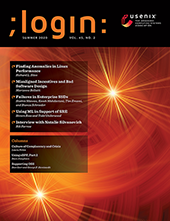
Who Will Pay the Piper for Open Source Software Maintenance? Can We Increase Reliability as We Increase Reliance?
;login: Enters a New Phase of Its Evolution
For over 20 years, ;login: has been a print magazine with a digital version; in the two decades previous, it was USENIX’s newsletter, UNIX News. Since its inception 45 years ago, it has served as a medium through which the USENIX community learns about useful tools, research, and events from one another. Beginning in 2021, ;login: will no longer be the formally published print magazine as we’ve known it most recently, but rather reimagined as a digital publication with increased opportunities for interactivity among authors and readers.
Since USENIX became an open access publisher of papers in 2008, ;login: has remained our only content behind a membership paywall. In keeping with our commitment to open access, all ;login: content will be open to everyone when we make this change. However, only USENIX members at the sustainer level or higher, as well as student members, will have exclusive access to the interactivity options. Rik Farrow, the current editor of the magazine, will continue to provide leadership for the overall content offered in ;login:, which will be released via our website on a regular basis throughout the year.
As we plan to launch this new format, we are forming an editorial committee of volunteers from throughout the USENIX community to curate content, meaning that this will be a formally peer-reviewed publication. This new model will increase opportunities for the community to contribute to ;login: and engage with its content. In addition to written articles, we are open to other ideas of what you might want to experience.

As software eats the world and open source eats software, IT supply chains and enterprise risk management postures are evolving. Topdown, CIO-led commercial software procurement is shifting towards bottom-up, developer-driven choices that increasingly involve open source software (OSS) [1]. Security in this context requires visibility, starting with a comprehensive inventory (software bill of materials) as well as an understanding of code provenance (software composition analysis). It also entails application testing, automated vulnerability scanning, instrumentation, and observability, which can provide insights for defenders. For organizations that plan over longer time horizons, however, mitigating OSS risk sometimes means taking on direct responsibility for software maintenance. Little by little, organizations are empowering staff to perform upstream code improvements that the rest of the world can access. When implemented thoughtfully, this pragmatic form of software stewardship can help
